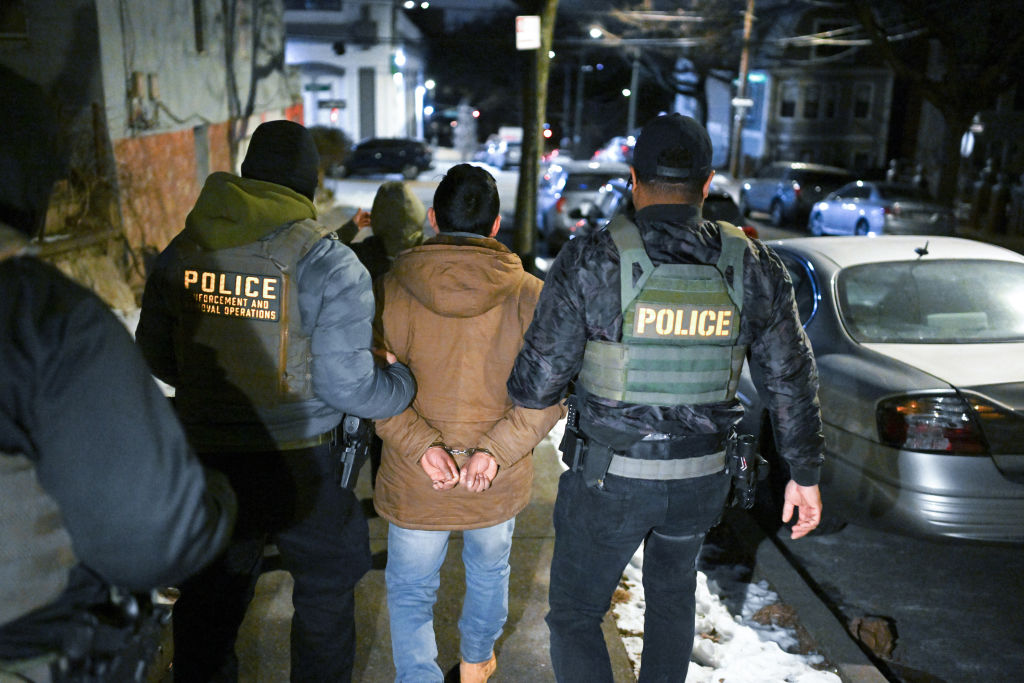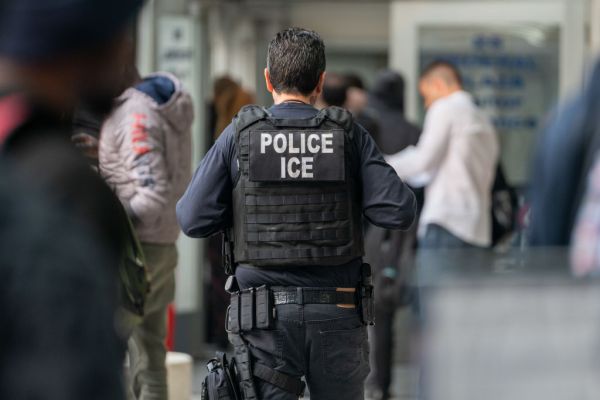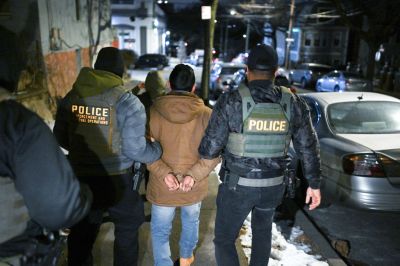Happy Tuesday! Valentine’s Day is just around the corner! Instead of (or in addition to) the standard-issue flowers or chocolates, we suggest giving your loved one the gift of a Dispatch membership—clear-eyed analysis, thought-provoking perspectives, and writing that makes you both smarter.
Quick Hits: Today’s Top Stories
- Hamas said on Monday that it would delay the release of additional Israeli hostages, which had been scheduled for Saturday, “until further notice.” The terrorist group’s announcement—which threatens to derail the U.S.-brokered ceasefire and hostage release deal—came amid Israeli and American outcry over the emaciated state of the three abductees who were freed last Saturday. On Monday, President Donald Trump called for the release of all of the remaining 73 hostages in the Gaza Strip by Saturday at noon, warning that “all hell is going to break out” otherwise. Meanwhile, the Israeli military’s Southern Command raised its readiness level and postponed leave for combat soldiers in apparent preparation for the resumption of fighting.
- President Trump on Monday imposed 25 percent tariffs on all aluminum and steel imports to the U.S., with no exemptions for any country. The move followed his announcement on Sunday that he would impose the tariffs along with reciprocal tariffs, which match the duties other countries have levied against the United States. Trump issued similar aluminum and steel tariffs in 2018, imposing a 25 percent duty on steel and 10 percent on aluminum while exempting Canada, Mexico, and other American trading partners. So far, the president has yet to announce any exceptions to this latest round of duties, though he hinted at a possible carve-out for Australia—one of the few countries with which the U.S. has a trade surplus.
- The Department of Justice on Monday ordered federal prosecutors to drop charges against New York City Mayor Eric Adams, saying that the indictment limited his ability to address illegal immigration and violent crime. Prosecutors charged Adams in September 2024 with bribery, wire fraud, conspiracy, and soliciting campaign contributions from foreign nationals, including receiving $100,000 worth of plane tickets and luxury hotel stays from people connected to the Turkish government. Prosecutors have not yet officially dismissed the case against Adams, who met with President Trump ahead of his inauguration last month.
- President Trump issued an executive order on Monday pausing the Justice Department’s enforcement of the Foreign Corrupt Practices Act, which bars American companies from bribing foreign governments in exchange for doing business in the country. The order directs Attorney General Pam Bondi to review the law—which was codified in 1977 and amended in 1998 to include foreign firms and individuals that accept bribes—and prepare new enforcement guidelines. Announcing the move, Trump argued the law had a chilling effect on Americans’ legal and legitimate overseas business dealings.
- A federal judge in Rhode Island said Monday that the White House had not fully adhered to his January 31 order to unfreeze federal spending. In the ruling—which marked the first time the Trump administration had been accused of defying a judicial mandate—Judge John McConnell called on the federal government to “immediately take every step necessary” to release billions of dollars in funding. The Trump administration moved to appeal the judge’s initial order on Monday. The ruling followed Vice President J.D. Vance’s claim on Sunday that “judges aren’t allowed to control the executive’s legitimate power.”
- Homeland Security Secretary Kristi Noem sent a February 7 memo to Treasury Secretary Scott Bessent requesting that some law enforcement personnel—including Internal Revenue Service agents—assist in the enforcement of immigration laws, the Wall Street Journal reported Monday. In addition to investigating financial networks related to human trafficking, the officials would have the authority to detain and deport illegal immigrants. Invoking President Trump’s “Securing Our Borders” executive order, Noem said the Treasury Department had “qualified law enforcement personnel available to assist with immigration enforcement.”
Trump’s Deportation Dilemma

By all appearances, President Donald Trump’s long-promised immigration crackdown is well and truly underway. In the weeks since he took office, public clashes with foreign leaders over deportee flights, TV star ride-alongs on enforcement sweeps, and videotaped raids have all projected frenzied activity toward the president’s goal of mass deportations. And in perhaps the highest-profile move yet, the Pentagon announced last week that the first batch of illegal immigrants—10 alleged gang members—had arrived at the U.S. naval base in Guantánamo Bay, Cuba, which the administration plans to use as a detention facility.
But despite the flurry of activity, the Trump administration’s early immigration enforcement efforts may not be on pace with the president’s sweeping promises. And the White House faces legal and logistical barriers ahead as it seeks to boost deportations.
Dating back to the presidential campaign, Trump promised to take immediate, drastic action on immigration. “We will begin the process of returning millions and millions of criminal aliens back to the places from which they came,” he said during his inaugural address.
On Friday, Trump’s “border czar” Tom Homan, told reporters that roughly 11,000 migrants had been arrested under the new administration. Immigration and Customs Enforcement (ICE) took to X to publish its daily arrest numbers, which peaked at 1,179 on January 26 before the agency stopped providing updates in February. Cops-style raids in cities across America gave the impression that Trump’s long-promised mass deportations had begun in earnest.
Behind the scenes, it may be a different story. Arrests are reportedly below the Trump administration’s target of 1,200 a day, as immigration authorities contend with manpower shortages and a lack of detention facilities. And even the high-end figures are in keeping with or below deportations under previous administrations. According to figures from the Department of Homeland Security (DHS), former President Joe Biden deported or removed 48,970 people, roughly 12,200 a week, in November 2024. And in his first year in office, former President Barack Obama oversaw the removal of 973,937 people—an average of more than 81,000 per month.
Ramping up those numbers will be difficult, in part due to ICE’s limited pool of possible detainees. Aside from arrests made at the border, wherein the Border Patrol detains migrants and turns them over to ICE for booking, the vast majority of ICE arrests occur in prisons and jails. Illegal immigrants “get booked into jail, they get fingerprinted, ICE gets a copy of their fingerprints, ICE moves in and issues a detainer,” John Sandweg, the former acting director of ICE and acting general counsel for DHS, told TMD. “And it takes custody of them when the criminal justice system is done.”
Now, the agency is trying to expand its pool by seeking out illegal immigrants with criminal records among the public. But because they are typically booked by ICE upon their initial arrest, such cases are few. There are “just not that many people that were booked into jail that ICE missed on the front end,” Sandweg said. “Because ICE gets 90 percent [of them] when they’re booked into jail, they don’t miss that many targets.” Even adding nonviolent and minor offenses to the list of arrest targets, along with “collaterals”—non-criminal illegal immigrants incidentally swept up in enforcement—the pool of potential arrests is difficult to increase with existing ICE capacities.
That upper ceiling may explain why ICE’s X account stopped posting daily arrest numbers at the end of last month, opting instead to publish the details of individual criminals who are being arrested and deported. And even if the administration can expand its target list, logistical and legal bottlenecks may stand in its way.
To start, the current immigration enforcement system simply does not have enough beds and supplies necessary to undertake a mass detention and deportation campaign. On Wednesday, White House press secretary Karoline Leavitt confirmed reports that of the roughly 8,000 migrants arrested by that date, 461 had already been released due to near-capacity usage of the 41,500 beds available to ICE. Trump hopes to significantly increase that capacity, including by expanding Guantánamo Bay’s detention facilities.
Immigration officials are also looking to mainland military bases, like Buckley Space Force Base in Colorado and Fort Bliss Air Force Base in Texas, as overflow sites. Cassandra Zimmer, an immigration policy analyst at The Niskanen Center, argued this option is significantly more cost-effective than sending detainees to Guantánamo. “If you’re going to house people,” she told TMD, “especially people who are from recalcitrant countries [those who resist receiving deportees] who could be in detention for a couple of months or indefinitely, [Guantánamo] is the most expensive way you could do it.”
In a report for Niskanen, Zimmer wrote that the prison in Guantánamo currently houses 15 prisoners at a price tag of $663 million—or around $44 million per prisoner—each year. Additional detainees would likely lower that average, but it would still be far more expensive than mainland facilities. When the U.S. housed 45,000 Haitian and Cuban migrants at the base in the mid-1990s, it cost the federal government $1 million per day ($2 million adjusted for inflation) in operating expenses and another $100 million ($205 million adjusted for inflation) to retrofit the base. In contrast, imprisonment in a maximum-security facility in the U.S. mainland costs around $95,000 a year—just above the cost of one flight for a detainee’s legal team.
For now, the high price tag of the administration’s promised immigration crackdown is one of its biggest obstacles. Trump recently signed into law the Laken Riley Act, an immigration law that ICE estimates would increase migrant detentions by roughly 60,000 a year and require an additional $26.9 billion in federal funding per year. But the legislation doesn’t include new funding for DHS, which may be looking to other departments to assist with immigration enforcement.
In a memo last week, Homeland Security Secretary Kristi Noem requested that Treasury Secretary Scott Bessent deputize law enforcement personnel—including Internal Revenue Service agents—to assist in arrests and deportations, the Wall Street Journal reported Monday. The appeal was in keeping with Trump’s sweeping executive orders corralling federal resources from a range of governmental agencies and departments—from the Pentagon to the Federal Bureau of Investigation—toward his goal of mass deportations.
But even if the administration can summon the resources necessary to see the effort through, legal hurdles would remain. “The one thing they’re not doing is surging resources to the immigration court,” Sandweg told TMD. Currently, the 900 immigration judges employed by the federal government face a backlog of more than 3.7 million cases—some 4,000 per judge.
Without a massive—and until now, unannounced—expansion in judicial capacity, the White House may look at other avenues for swiftly removing unauthorized migrants. Last month, Trump issued an executive order classifying illegal immigration as an “invasion,” and another designating international cartels as foreign terrorist organizations. The latter order directed agencies to begin preparing to enforce the Alien Enemies Act, a 1798 law allowing the president to detain and deport noncitizens from an enemy country during wartime.
That invocation, together with the ongoing ramp-up in law enforcement capacity, could signal Trump’s push to expand his immigration crackdown beyond business as usual. Until then, ICE will continue to be limited by the same obstacles faced by Biden, Obama, and the first Trump administration: the blunt logistical challenges of not enough beds and too few judges.
“Everything they’re doing genuinely looks to me like they’re very serious about accomplishing this,” Sandweg said. “They’re embarking on a path that could actually be successful, subject to the big caveat: if they’re able to bypass the courts.”
Worth Your Time
- For the New York Times, Ephrat Livni recounted recently freed Israeli hostages’ stories of abuse and torture at the hands of their terrorist captors—and reflected on the chilling implications for the abductees who remain in the Gaza Strip. “Dr. Hagai Levine, who leads the medical team for the Hostage Family Forum, an umbrella group, told reporters on Monday that the hostages had been ‘starved’ and endured ‘intentional torture,’ and that many had returned home with infections that could become a threat, as well as emotional damage. ‘The findings are clear and deeply alarming,’ he said. ‘They are subject to deliberate starvation and severe water deprivation’ and ‘are undergoing extreme physical and emotional abuse,’ she reported. “Ofer Calderon, who was released earlier this month, said in a statement on Monday, ‘I was held in tunnels without seeing daylight, had no access to media, experienced severe hunger conditions, went entire months without showering or receiving proper care.’ He called for a continuation of the cease-fire and noted that after the first temporary deal of the war was struck between Israel and Hamas, in November 2023, the conditions during his and other hostages’ captivity had ‘severely deteriorated and became brutal.’ ‘We must not stop the current deal and must continue working to free all the hostages,’ Mr. Calderon said. ‘Hamas is a cruel enemy who will not hesitate to harm the hostages left behind.’”
Presented Without Comment
Politico: Britain to ‘Wait and See’ on Trump’s Tariff Threat
Also Presented Without Comment
New York Times: For Google Maps Users in U.S., It’s Now the Gulf of America
In the Zeitgeist
A trailer for Marvel’s new antihero movie, Thunderbolts, dropped Sunday. Is it just us, or does Julia Louis-Dreyfus’ character—the film’s scheming Central Intelligence Agency head—resemble a certain nominee for director of national intelligence?
Toeing the Company Line
- In the newsletters: Kevin D. Williamson wrote about Donald Trump’s protectionist predecessors: 1980s Democrats.
- On the podcasts: Dr. Einat Wilf joined Adaam James Levin-Areddy to discuss Trump’s plan for Gaza on The Dispatch Podcast, and Sarah Isgur and David French went to Stanford University to unpack antisemitism in higher education, gender identifiers for government employees, and more on the latest Advisory Opinions.
- On the site: Mike Warren looks at Trump’s honeymoon phase, Justin Stapley explains how the Founding Fathers warned against a spoils system, and Daniel McKivergan examines how Edward Snowden’s release of National Security Agency documents helped China.
Let Us Know
Do you think using the base at Guantánamo Bay to house illegal immigrants is a good idea?









Please note that we at The Dispatch hold ourselves, our work, and our commenters to a higher standard than other places on the internet. We welcome comments that foster genuine debate or discussion—including comments critical of us or our work—but responses that include ad hominem attacks on fellow Dispatch members or are intended to stoke fear and anger may be moderated.
With your membership, you only have the ability to comment on The Morning Dispatch articles. Consider upgrading to join the conversation everywhere.